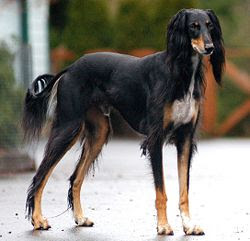
Saluki
Dog of the Bedouin
The Saluki is a sighthound that arguably could be one of the oldest dog breeds. They originate from the Middle East, where they were and still are kept by the nomadic Bedouin tribesmen. Also referred to as the Royal Dogs of Egypt, dogs bearing a striking resemblance to today’s Saluki grace many Egyptian relics.
Dog of the Bedouin
The Saluki is a sighthound that arguably could be one of the oldest dog breeds. They originate from the Middle East, where they were and still are kept by the nomadic Bedouin tribesmen. Also referred to as the Royal Dogs of Egypt, dogs bearing a striking resemblance to today’s Saluki grace many Egyptian relics.
Appearance
The Saluki is a slim, elegant, and graceful breed. They are longer than they are tall, standing between 22-28 inches at the shoulder, and weighing in at 31-55 pounds. Their coat is short and smooth, with silky feathered hairs on its long ears and legs. Their tail is long and carried in a natural curve with more feathering on the underside. There is a smooth variety, although it is rare, with a slightly coarser fur. The coat can be a wide range of colors including, white, cream, fawn, golden, red, grizzle, tri color (white, black, and tan), and black and tan. Salukis that have a white patch at the base of the neck are known by the Bedouins to have the “Kiss of Allah”, and are especially prized.
History
The name Saluki likely derives from either the former Arabian city of Saluk or from Seleukia of ancient Syria. Carvings depicting dogs that resemble the breed exist from ancient Sumeria and Egypt dating back as far as 7000 BC. There are even stone inscriptions of King Tutankhamen hunting with a pair of these dogs, and several mummified bodies have been found. Traditionally dogs in general are considered unclean in the Islamic culture, but to the Bedouins, the Saluki is considered a holy gift from God. These prized dogs are known as the “Noble One” and allowed to sleep in their master’s tents. They were used to hunt a wide variety of prey such as gazelles, foxes, jackals, and hares, often working in tandem with hawks. Their people held them in such high regard that to protect their feet from the hot sand they were carried to the hunt on camels. Salukis were never bought or sold; instead they were given as gifts of friendship or homage.
Temperament
A Salukis interests can be varied, at one moment they can be quiet and dignified, and in the next playful. They bond strongly with their owners, yet still crave independence. They rarely bark, so when it does occur you should listen to its concerns. This breed does well with older children and with similar dogs. Because of the Salukis hunting instinct it is difficult to have any non-canine pets in the household.
Health and Care
Salukis in general are a healthy breed with a lifespan is around 12 years. They have few genetic diseases, but can be prone to some eye diseases and cancer. Salukis, as with most sighthounds are often sensitive to anesthesia.
Most Salukis can adapt to apartment life, but only if they are regularly exercised. However, they do best with a large, high fenced yard. Regardless of the amount of room at home they need long, brisk walks daily, and preferably somewhere safe to run. They should never be allowed of lead as their prey instinct can easily take over, and they can reach speeds of 40 mph with a lot of endurance. Bred for the extreme heat Salukis thrive in warmer climates.
Salukis are fairly easy to keep groomed, but their longer feathered areas should be brushed regularly to prevent matting. They are average shedders.